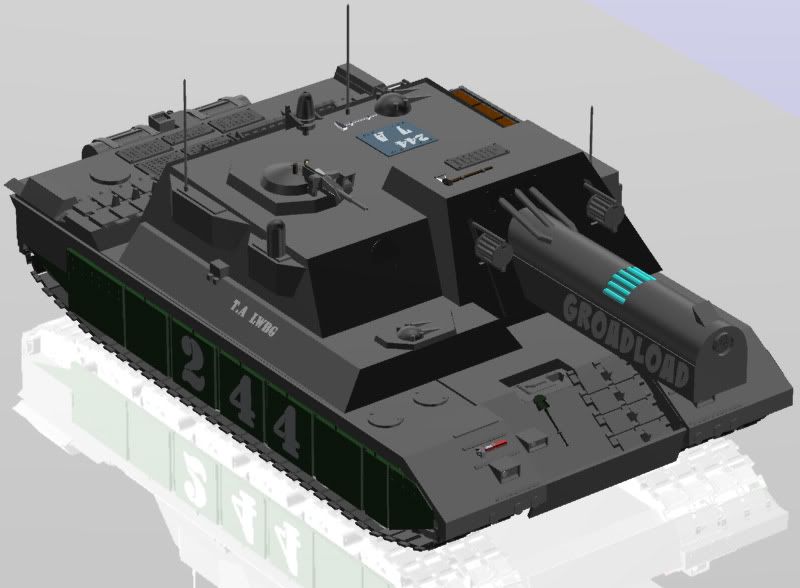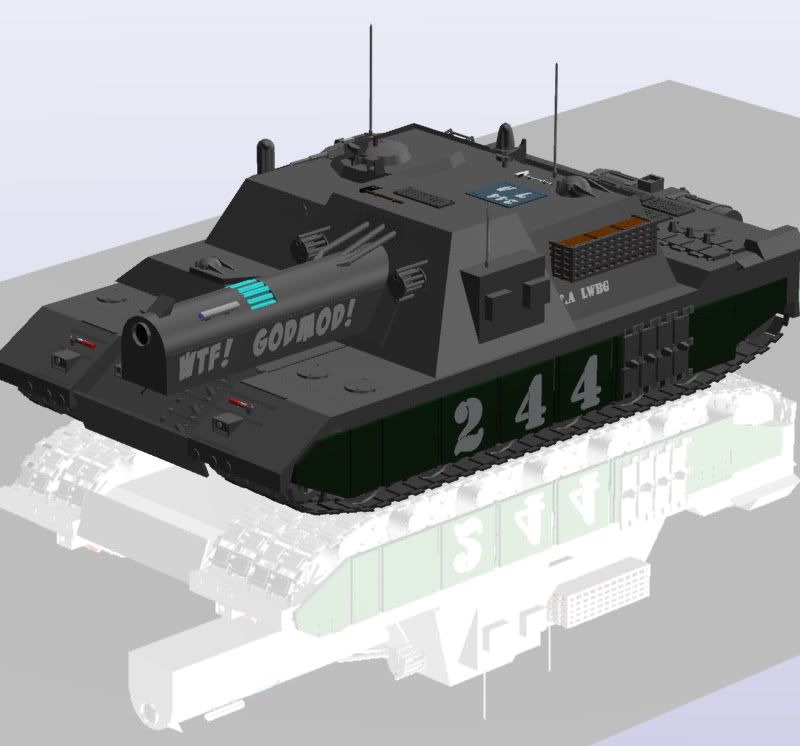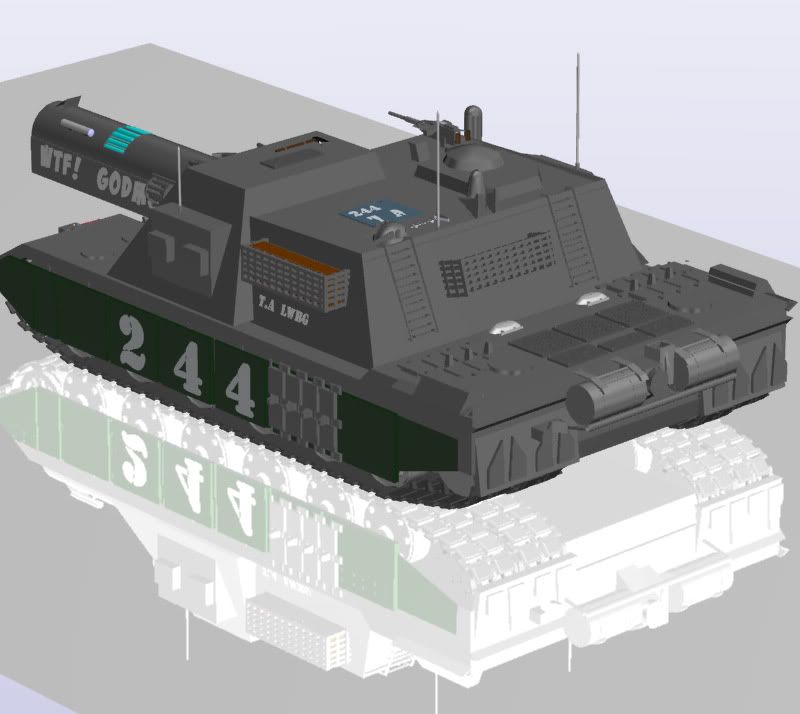Hood Plasma Tank
Contents
Quick run down on the Hood Plasma Tank
Length (hull): 9m
Length: (incl. gun): 11.5m
Width: 5.5m
Height: 4.9m
Ground clearance: 0.5m
Speed: 59 kph (road); 40 kph (mean cross country)
Weight: 95 tonnes.
Shortened account of the development of the Hood Plasma Tank
The “Hood” Plasma tank is a specific niche weapon in the Midlonian Armour, after the retirement of the ancient “Hedrick” Open-topped Assault gun pieces in 2010, after a use of almost 90 years in the Midlonian Armed forces. The need for a newer, more advanced “niche” weapon of the assault-gun category was deemed necessary by the Ministry of Defence in late 2010 after the humiliating defeat at the Rebellion of Odin’s Hill [see attached history files below].
Initially designated “XA-233” and designed around a heavy rocket-propelled gun. Major mechanical problems plagued XA-233, as despite large degrees of Health and Safety being taken the guns were known for critical backfiring, due to jamming if reloaded rapidly. The volatile shells, containing slush hydrogen propellant was also deemed as too dangerous. XA-233 was officially laid to rest on the 30th August, 2012.
At the dawn of 2013 a scientific team at Vickers Defence Inc. made a breakthrough in energy weapons, The project, now celebrated in Midlonian Scientific circles, was simply known by number: “845”. Project 845 was an investigation of the application of super-heated Hydrogen as a weapon. The system is outlined in the “sanitized” briefing put before the MoD on the 24th of January, 2013.
Water is initially fed into the main reservoir, here electromagnetic plates are powered at the Hydrogen is separated from the Oxygen, the Hydrogen is fed from a main source into a reservoir before being super-heated via the usage of a nuclear fusion reactor, when the Hydrogen is sufficiently “charged” it can be controlled and released via heat-resistant valves and funnelled away and released. Its effects are quite devastating at ranges of approximately 5 to 1200 yards.
Approval for the usage and refinement of the weapon was on the 30th of January, and ratified by the Department of Budgets on the 3rd of February. Initial problems with XA-845 was that there currently was not a sufficient chassis to carry the equipment necessary, however a dozen re-enforced “Gresley” Tank chassis were provided, gratis, by VDI after an administration error caused an unnecessary surplus. Progress was rapid with the initial prototype, numbered 845001 being sent to the testing grounds outside of Milton Keynes. Testing was done by one of the many testing crews at the facility, an account by Harry Murdock, a young and pasty faced observer back in 2013 wrote this in his book Runner to Rear Admiral.
I think my favourite memory for my time as an observer at Milton Keynes was on the 23rd of May, 2013, when I witnessed the testing of what we all now know as the Pistoleer. I stood behind the blast screen and witnessed it simply annihilate a concrete block nearly 10 metres thick, this was indeed tested again at 20 and 30 metre thick blocks, all of which were simply boiled away by the gun. Its perhaps the most potent tank we shall ever field in His Majesties Armed forces.
With the tank passing the rigorous tests, was accepted into the ranks of the Armed forces, and production for over 100 were ordered for rigorous field testing, some of which were used in the suppression of Odin’s rebellion.
Historical text, Hoods in the field
Odin’s Rebellion
The Winter of 2012 to the Summer of 2013 was a period of great unrest for the Greater Kingdom, a small but popular separatist movement began to gain momentum on the Small island of Pushan, Birchester. The movement was lead by a mysterious figure, simply known as “Odin” by the followers who seemed to revere him as some sort of Demi-God, with many Government installations calling for help from the Home Government, and after an arson attack on the consul building of the Island, the Gorman Administration obliged reluctantly, and sent in a single Battalion [the 84th] to the tiny Island, no more could be sent, simply because it would be unable to fit on the island-city. After a few civil disturbances and a riot in a several suburbs, the consul declared Martial Law.
Battle of Odin’s Hill
A well known stronghold of the Followers of Odin was the Necropolis of the Island atop of a Hill to the Northwest of large-island city. This was assaulted by the 45th Armour company on the dawn of Friday 12th December 2012, the Hedrick Assault gun had been retired just a few months earlier, the Commander, one Dennis Arthur Bloodnok was confident in his unit’s ability to simply:
“Rout those naughty, naughty people.”
However this was not to be, a bewildering array of aged weapons had gotten into the hands of the Followers of Odin, old Pak and Ack-Ack guns had been taken from Museums and an abandoned MoD stockpile under the city. They fired down on the tanks and infantry as they assaulted the hill. It was soon discovered that the Gresley tanks rounds were not effective against the targets hiding in the Mausoleums and Grave-towers, the rounds punched through and often missed their elevated targets. After a ferocious fire fight that lasted some six hours, what remained of the 45th Armoured, now reduced to just 36 tanks withdrew. After a further few weeks, and complete inability to engage strong points and buildings effectively, the 84th Battalion was forced to the South of the City, where a wide set of transportation links severed the city in two, and created a wider plain where the distance, and lack of Cover finally played to the advantage of the 84th, and the Followers held a tight grip on the Northern section of the Island. A need for a large-calibre weapon to destroy hard points was evident.
Operation Steel Toecap
With the rapid construction of the first 100 “Pistoleer” Plasma Tanks taking place from the Early summer of 2013, it was decided that some 20 would be delivered to the stricken 84th Battalion.
It was decided that these new tanks would be deployed as part of the Battalion’s counter-attack [codenamed Steel Toecap]. With the new tanks at the fore, progress was swift and within a few days Odin’s Hill, and indeed the rest of Pushan was re-captured. The final battle revolved around a four hour gunfight at a giant temple-like Grave tower, which was mostly destroyed by fire from the new tanks before being stormed by members of the 45th and 402nd companies. When they stormed the mausoleum they were horrified by what they saw, defiled dead and ritualistic killings had been taking place in what the Followers had converted into a temple to their “Demi-God”. Fragments of Odin’s seared body were later recovered and he has been confirmed dead, though rumours of his followers across the Kingdom still persist.
The Tanks were then used to destroy what remained of the building.
Thus the Hood became a valued part of the Midlonian Armoury.
The hulls used by XA-233 were later used, ironically, as range finders and gunnery practise by the Hood Plasma tanks.
Pictures



“Hood” Plasma Tank of the Second Territorial Army Land Warfare Battle Group, Tank number 44 Basildon. [works number 8450203]
